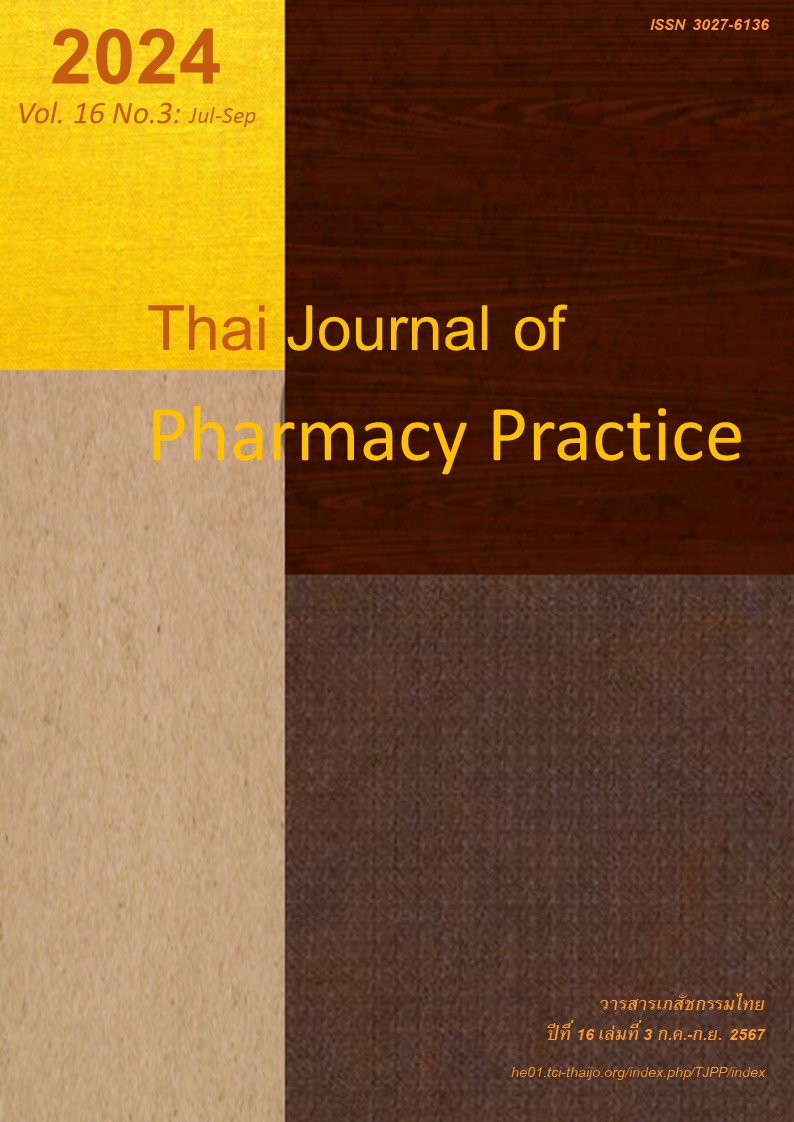การรับรู้ พฤติกรรม และเหตุปัจจัยอันนำไปสู่การใช้ยากลุ่มเบนโซไดอะซีปีน ในผู้ป่วยที่ได้รับยาเมทาโดนระยะยาว ณ โรงพยาบาลแห่งหนึ่งในภาคเหนือ
Main Article Content
บทคัดย่อ
วัตถุประสงค์: เพื่อศึกษาการรับรู้ พฤติกรรม และเหตุปัจจัยอันนำไปสู่การใช้ยากลุ่มเบนโซไดอะซีปีน (benzodiazepines, BZDs) ในผู้ที่ได้รับยาเมทาโดนระยะยาว ณ โรงพยาบาลแห่งหนึ่งในภาคเหนือ วิธีการ: การศึกษาเก็บข้อมูลโดยการสัมภาษณ์เชิงลึกจากผู้ให้ข้อมูล 13 รายที่รักษาด้วยยาเมทาโดนที่โรงพยาบาลแห่งหนึ่งในภาคเหนือ โดยเลือกแบบเจาะจงจากผู้ที่ได้รับยาเมทาโดนระยะยาวร่วมกับ BZDs อย่างน้อย 1 รายการ หรือมีพฤติกรรมร้องขอ BZDs จากบุคลากรทางการแพทย์ และยังเลือกโดยวิธีการบอกต่อเพื่อค้นหาผู้ที่ได้รับ BZDs จากแหล่งภายนอก ผลการวิจัย: การรับรู้ต่อ BZDs ของผู้ใช้ยานี้แตกต่างกันไปตามวัตถุประสงค์ของการใช้ยา ผู้ที่ใช้เพื่อรักษาอาการเจ็บป่วยรับรู้ว่า BZDs คือ ยานอนหลับ ยาคลายเครียด และยารักษาอาการวิตกกังวล โดยใช้ด้วยวิธีรับประทานเป็นหลัก ในขณะที่ผู้ที่ใช้เพื่อความสนุกสนานและเคลิ้มสุขในรูปแบบสารเสพติด รับรู้ว่าเป็นยาเมาหรือยากดประสาท และใช้ยาด้วยวิธีอมหรือผสมกับยาเมทาโดนเพื่อฉีดเข้าสู่ร่างกาย ปัจจัยที่นำไปสู่การใช้ยา คือ ปัญหาสุขภาพทางใจและกาย ปัญหาทางด้านครอบครัวที่ขาดความเข้าใจในกระบวนการรักษาด้วยยาเมทาโดน การคบเพื่อนที่ชักนำกันไปใช้ยา อาชีพที่ทำให้เกิดความเครียด การอาศัยในชุมชนเมืองที่สามารถเข้าถึงยาได้ง่าย การจำกัดปริมาณการจ่ายยาจากโรงพยาบาลรัฐ และกฎหมายในการควบคุม BZDs สรุป: ผู้ใช้ยาเมทาโดนมีมุมมองการรับรู้เกี่ยวกับ BZDs แตกต่างกัน เมื่อไม่ได้รับการรักษาอาการเจ็บป่วยในรูปแบบที่ตนเองต้องการจากโรงพยาบาล จึงมีการค้นหาวิธีเยียวยาตนเองจากแหล่งอื่น ไม่เพียงแต่รักษาอาการเจ็บป่วยทางกาย บุคลากรทางการแพทย์ควรทำความเข้าใจมุมมองของผู้ใช้ยาเมทาโดนมากขึ้น รวมไปถึงค้นหาเหตุปัจจัยที่เกี่ยวข้องอันนำไปสู่การใช้ยา
Article Details

อนุญาตภายใต้เงื่อนไข Creative Commons Attribution-NonCommercial-NoDerivatives 4.0 International License.
ผลการวิจัยและความคิดเห็นที่ปรากฏในบทความถือเป็นความคิดเห็นและอยู่ในความรับผิดชอบของผู้นิพนธ์ มิใช่ความเห็นหรือความรับผิดชอบของกองบรรณาธิการ หรือคณะเภสัชศาสตร์ มหาวิทยาลัยสงขลานครินทร์ ทั้งนี้ไม่รวมความผิดพลาดอันเกิดจากการพิมพ์ บทความที่ได้รับการเผยแพร่โดยวารสารเภสัชกรรมไทยถือเป็นสิทธิ์ของวารสารฯ
เอกสารอ้างอิง
Kummuang S, Panthuan S, Kongsitrattanatrakul T, Dokshan P. Public policy on drug prevention and suppression of Thailand. Dhammathas Academic Journal 2022; 22: 409-20.
Princess Mother National Institute on Drug Abuse Treatment. Harm reduction services guide for providers. Bangkok: Chulapress; 2018.
Princess Mother National Institute on Drug Abuse Treatment. Methadone maintenance treatment. Bangkok: Chulapress; 2010.
National Institute on Drug Abuse. Benzodiazepines and opioids [online]. 2019 [cited June 10, 2023]. Available from: www.nida.nih.gov/research-topics/opi oids/benzodiazepines-opioids.
Mathers BM, Degenhardt L, Phillips B. Global epide-miology of injecting drug use and HIV among people who inject drugs: a systematic review. Lancet 2008; 372: 1733-45.
World Health Organization. Guidelines for the psychosocially assisted pharmacological treatment of opioid dependence. Geneva: World Health Organiza- tion; 2009.
Griffin CE, Kaye AM, Bueno FR, Kaye AD. Benzodiazepine pharmacology and central nervous system-mediated effects. Ochsner J 2013; 13: 214–23.
Aumpon V. Study of measures resolving the abuse of psychotropic substances consumption on benzodia-zepines group. FDA Journal 2013; 20: 21-9.
Sun EC, Dixit A, Humphreys K. Association between concurrent use of prescription opioids and benzodia- zepines and overdose: retrospective analysis. BMJ 2017; 356: 760. doi.org/10.1136/bmj.j760.
Karahong K, Suwannaprom P, Ruanta Y, Awiphan R. Meaning and perceptions toward benzodiazepine use behavior in the view of people in rural community. Thai Journal of Pharmacy Practice 2018; 10: 264-75.
Kleinman A. Concepts and a model for the compari son of medical systems as cultural systems. Soc Sci Med 1978; 12: 85-93.
Sallis JF, Owen N, Fisher EB. Ecological models of health behavior. In: Glanz K, Rimer BK, Viswanath K, editors. Health behavior and health education: Theory, research and practice. 4th ed. San Francisco: Jossey-Bass; 2008. p 465-85.
Kevin WC, Christine CB, Darlene PF, Christopher DA, Eric W, Devang G. Benzodiazepine use and misuse among patients in a methadone program. BMC Psychiatry 2011; 11: 90. doi: 10.1186/1471-244 X-11-90.
Kim J, Jesus OD. Medication routes of administra- tion [online]. 2022 [cited Feb 14, 2023]. Available from: www.ncbi.nlm.nih.gov/books/NBK568677.
Ashton H. The diagnosis and management of benzo- diazepine dependence. Curr Opin Psychiatry 2005; 18: 249-55.
Weschules DJ, Bain KT, Richeimer S. Actual and potential drug interactions associated with methadone. Pain Med 2008; 9: 315-44.
Stein MD, Kanabar M, Anderson BJ, Lembke A, Bailey GL. Reasons for benzodiazepine use among persons seeking opioid detoxification. J Subst Abuse Treat 2016; 68: 57-61.
Laoniramai P, Laosee OC, Somrongthong R, Wongchalee S, Sitthi-Amorn C. Factors affecting the experiences of drug use by adolescents in a Bangkok slum. Southeast Asian J Trop Med Public Health. 2005; 36: 1014-9.
Bush DM, Lipari RN. Substance use and substance use disorder by Industry [online]. 2015 [cited Feb 20, 2023]. Available from: www.samhsa.gov/data/sites/ default/files/report_1959/ShortReport-1959.
Sriprasert D. Medical dominance and the doctor-patient relationship. Thammasat Journal 2018; 37: 78-95.
The Act on Promulgation of Narcotics Code. Royal Gazette No. 138, Part 73A (Nov 8, 2021).


